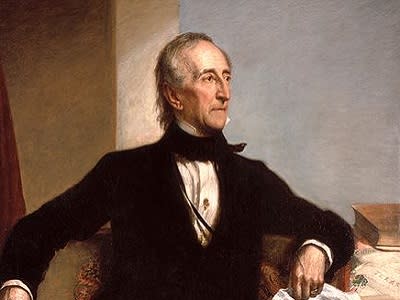Looking back: One of the ugliest protests in White House history
This weekend marked the anniversary of a low-mark in White House history, as an angry crowd led a U.S. president to fear for his family’s safety—and also led to the strengthening of a police force to protect him and other District of Columbia residents.
President John Tyler
It was on August 16, 1841 that President John Tyler stunned his fellow members of the Whig Party by using his constitutional powers to veto a bill to revive the Second Bank of the United States.
Two days later, an angry drunken mob showed up at the White House late at night, firing guns and hanging Tyler in effigy in front of the mansion. The President was living there with his family, unprotected by security. Members of his family feared for their safety, according to accounts of the incident.
A painter later was arrested for throwing rocks at President Tyler in another incident as Tyler walked the grounds at the White House. The President declined to press charges.
The violence led Congress to expand the small security force in the District of Columbia in 1842 to patrol the city at night.
So why would a mob gather at the White House and threaten a President, with no opposition?
The banking law—and the issue of a Bank of the United States–was championed by the powerful House and Whig Party leader Henry Clay and it was seen by the Whigs as a key move to break out of a troubled economic slide.
President Tyler, a former Jacksonian Democrat from Virginia who joined the Whig Party, explained that he thought the bill was unconstitutional and it infringed upon the rights of the states, particularly because of the federal government’s power to override a state’s objections to hosting a branch bank in a state.
The veto wasn’t totally unexpected, but there was hissing in the congressional gallery when it was announced, especially since the move was made by a President overriding his own party’s wishes.
Historian Gary May from the University of Delaware has a detailed account of Tyler’s problems in his book on Tyler in “The American Presidents” series.
May says there were two crowds that descended on the White House on August 18, 1841. The first shot guns in the air and shouted “down with the veto.” A second crowd arrived house later with a scarecrow-like figure of Tyler that was hanged and then set on fire.
Similar protests were repeated around the country as news spread about the veto.
The violence only hardened Tyler’s determination to oppose Clay. Then a letter published by a former friend of Tyler’s, Representative John Minor Botts, insulted Tyler’s honor as a Virginian.
Tyler and Clay locked horns in an ugly political battle that ended with the President’s expulsion from his own party while he was in office.
However, Tyler was able to block the return of the Bank of the United States using his veto power.
Since the Tyler incident, there have been plenty of peaceful protests in the White House area, where citizens can express their First Amendment rights. But the protests have been contained in secure areas.
Recent Historical Stories
Five little-known men who almost became president
Marking the passing of maybe the most-criticized president ever



